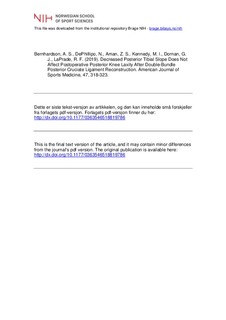| dc.contributor.author | Bernhardson, Andrew S. | |
| dc.contributor.author | DePhillipo, Nicholas | |
| dc.contributor.author | Aman, Zachary S. | |
| dc.contributor.author | Kennedy, Mitchell I. | |
| dc.contributor.author | Dornan, Grant J. | |
| dc.contributor.author | LaPrade, Robert F. | |
| dc.date.accessioned | 2019-04-25T07:33:21Z | |
| dc.date.available | 2019-04-25T07:33:21Z | |
| dc.date.created | 2019-01-22T09:28:08Z | |
| dc.date.issued | 2019 | |
| dc.identifier.citation | American Journal of Sports Medicine. 2019, 47, 318-323. | nb_NO |
| dc.identifier.issn | 0363-5465 | |
| dc.identifier.uri | http://hdl.handle.net/11250/2595362 | |
| dc.description | I Brage finner du siste tekst-versjon av artikkelen, og den kan inneholde ubetydelige forskjeller fra forlagets pdf-versjon. Forlagets pdf-versjon finner du på sagepub.com: http://dx.doi.org/10.1177/0363546518819786 / In Brage you'll find the final text version of the article, and it may contain insignificant differences from the journal's pdf version. The definitive version is available at sagepub.com http://dx.doi.org/10.1177/0363546518819786 | nb_NO |
| dc.description.abstract | Background: Recent clinical studies identified sagittal plane posterior tibial slope as a risk factor for increased postoperative laxity after single-bundle posterior cruciate ligament reconstruction (PCLR). Purpose/Hypothesis: To retrospectively compare the degree of posterior tibial slope and its effect on posterior tibial translation (PTT) after double-bundle (DB) PCLR. Our null hypothesis was that preoperative tibial slope would not be associated with graft laxity. Study Design: Case series; Level of evidence, 4. Methods: Patients who underwent DB PCLR between 2010 and 2017 by a single surgeon were retrospectively analyzed. Measurements of posterior tibial slope were performed on lateral radiographs, and PTT was measured with pre- and postoperative kneeling stress radiographs. Simple and multiple linear regression was performed to estimate the unadjusted and adjusted effect of tibial slope on postoperative graft laxity, respectively. Results: A total of 103 patients with posterior cruciate ligament tears and subsequent reconstructions were included. There was a significant reduction of the mean ± SD side-to-side difference in PTT between stress radiographs (preoperative, 10.6 ± 2.7 mm; postoperative, 1.5 ± 2.6 mm; mean difference, 9.1 mm; 95% CI, 8.4-9.8; P < .001). Linear regression analysis revealed no significant correlation between preoperative posterior tibial slope and the amount of side-to-side difference in PTT on postoperative stress radiographs obtained at a mean 18.5 months (R = −0.115, P = .249). Combined ligament injury (beta = −1.01; 95% CI, −2.00 to −0.01; P = .047) was a significant independent predictor of decreased postoperative side-to-side difference in PTT. Conclusion: Graft laxity, determined by PTT in posterior kneeling stress radiographs, was not influenced by decreased posterior tibial slope after DB PCLRs. The observed results in the current study support the use of DB PCLR. Future studies should be conducted to compare the effect of tibial slope after SB PCLR and DB PCLR at long-term follow-up. | nb_NO |
| dc.language.iso | eng | nb_NO |
| dc.subject | posterior cruciate ligament | nb_NO |
| dc.subject | tibial slope | nb_NO |
| dc.subject | posterior tibial translation | nb_NO |
| dc.subject | kneeling stress radiographs | nb_NO |
| dc.subject | posterior knee instability | nb_NO |
| dc.title | Decreased Posterior Tibial Slope Does Not Affect Postoperative Posterior Knee Laxity After Double-Bundle Posterior Cruciate Ligament Reconstruction | nb_NO |
| dc.type | Journal article | nb_NO |
| dc.type | Peer reviewed | nb_NO |
| dc.description.version | acceptedVersion | nb_NO |
| dc.source.pagenumber | 6 | nb_NO |
| dc.source.journal | American Journal of Sports Medicine | nb_NO |
| dc.identifier.doi | 10.1177/0363546518819786 | |
| dc.identifier.cristin | 1662650 | |
| dc.description.localcode | Seksjon for idrettsmedisinske fag / Department of Sport Medicine | nb_NO |
| cristin.unitcode | 150,34,0,0 | |
| cristin.unitname | Seksjon for idrettsmedisinske fag | |
| cristin.ispublished | true | |
| cristin.fulltext | postprint | |
| cristin.qualitycode | 2 | |
